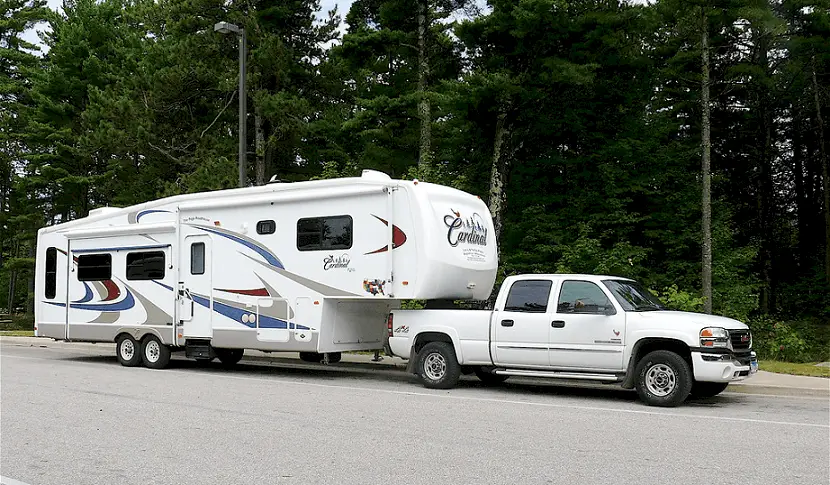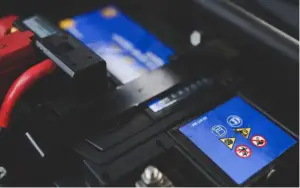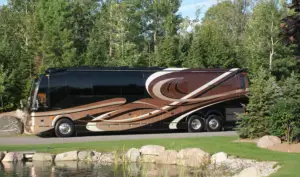When buying a fifth wheel, one of the most challenging parts is getting used to hitching and unhitching it.
Fifth wheel hitches are handy. They facilitate turning and eliminate cumbersome maneuvering, especially when driving in parks.
When going for road trips or camping, a spacious 5th wheel RV is just the type of RV you need. However, the problem comes when hitching it for the next drive.
In this post, I will provide you with detailed and step by step guide on hitching and unhitching a fifth wheel.
Hitching a Fifth Wheel
Learning how to hook up your fifth wheel correctly is very important before you can hitch-up and haul it.
If the it is not hitched properly, it can drop onto the bed of your truck and cause serious damages.
In the following guide, I provide a step by step guide on connecting a fifth wheel to the tow truck.
1. Read the Instruction
The first step in hitching is to familiarize yourself with the work involved in hitching.
When purchasing a fifth wheel, most of them come with instructions on how to hitch. These instructions will help you determine if you are up to the task or you need help.
If you think you can’t do it alone, you can ask for help from a friend or family member.
2. Get the Tools Ready
Before you start the process of hitching the 5th wheel, you should gather all the required tools.
This will help you save time and identify any missing tools. Some of the tools required include a
- Flashlight
- Work gloves
- Socket set
- Screwdriver
- Trim tools
- Tape measure
Make sure you assemble the tools in a toolbox so that it will be easy to reach out.
3. Chock the Wheels of your Vehicle
The next step is to place wheel chocks on the front wheels of your vehicle. This is for safety purposes to ensure your vehicle is stable enough.
Moreover, you can jack up your vehicle. This will depend on the particular hitch and your working space. Jacking up your vehicle provides enough space underneath.
4. Position the Work Light
Having enough light, when working underneath the vehicle is essential. Make sure you set up the light in the right position to illuminate your working space.
Additionally, the extra light will help you see smaller components easily, such as bolts and holes.
5. Remove the Spare Tire
Hitching a fifth wheel will require you to access the underneath of your truck bed.
This is especially true if the fifth wheel has brackets and base rails. Removing the spare tire will provide you with more space to work on.
Moreover, you will need to remove other components that may hinder your work. However, this step is not necessary, whereby the spare tire does not affect the hitching process.
6. Set up the Base Rail
The next step in hitching 5th wheel is to place the base rain in the right position. Make sure you have the correct measurements from the front of your vehicle bed.
You can refer to the measurements on the instruction manual. The right position to place the rail varies depending on if you have a short bed or long bed truck.
When setting up the base rail, you need to ensure the truck bed is free from bolts and plugs.
Therefore, you should remove any bolts and plugs to make way for the hitch frame.
7. Find the Drill Locations
In this step, you need to make the first drills for hitching. To mark the drill locations, you should first ensure the base rail is correctly positioned. Then mark the bolt holes using a pen.
When you finally mark one of the drill locations, you can now make holes.
Then you should position the 5th wheel bracket to correspond to the pilot hole you just drilled.
If the bracket lines of the fifth wheel are in the correct position with the hole, you can drill the remaining holes. Mark them with a pen and drill down from above your vehicle.
8. Bolt Down the Fifth Wheel

In this process, ensure all the pilot holes are large enough to accommodate the bolts of the fifth wheel.
If the bolt holes are drilled to the proper size, you should pain any exposed metals to prevent corrosion.
Then place the appropriate brackets on both sides of your vehicle bed and fasten them with nuts and bolts.
Position the base rail again on the right bolt hole locations. With the tails in position, insert the bolts on the holes and secure them with some nuts underneath the vehicle bed.
9. Position the Hitch and Attach
Once you have prepared your vehicle and you are sure that all hardware is in the right place.
The next step is to place the hitch into position. In this step, you may need assistance to lift the hitch.
Trailer hitches can be quite heavy and weigh up to 50lbs. In this step, make sure that you only tighten the bolts and the nuts to hold the hitch in place.
10. Tighten all the Bolts
This is an important step in setting up a hitch.
The last step is to torque the hitch safely in place. It involves tightening all the bolts and nuts.
The amount of torque depends on the size of the bolts and also as per the specified values in the instruction manual. In this step, make sure that all pins and other components are well installed and in place before you hitch up to tow.
With your flashlight, check the jaws to ensure they are closed and locked around the kingpin.
Check the taillights, brake lights, and signals if they are working properly. You should also inspect the fifth when and tow vehicle tires if they are properly inflated.
Lastly, you should raise the landing jacks to about 1 to 2 inches off the ground to remove the chocks. Test the trailer brake function. If the fifth wheel hitch is well secure, you can now remove the landing jacks.
Lets move to unhooking steps now.
Unhitching a Fifth Wheel
Unhitching a fifth wheel is easier than hitching. However, you need to be careful with safety purposes. Follow the steps below on unhitching.
Lets see the steps in disconnecting the fifth wheel from truck bed.
1. Getting Situated
The first step in unhitching is to find a level site. Avoid uneven ground while hooking up as well as when unhooking it.
Then situate the fifth wheel where you want to park it after unhitching.
Once you park, the first thing to do is to chock your wheels and make sure they are secured. This is to avoid the trailer moving while in the process of unhitching. Make sure you put chocks on both sides of the trailer.
It is essential to ensure that your RV is leveled out well. You can use leveling blocks to ensure your vehicle is stable.
2. Disconnect
The next step in the unhitching 5th wheel is to disconnect the brake cable, emergency brakes, and chains.
Before you disconnect, make sure you engage the vehicle parking brake. In this step, make sure you set up the landing gear before releasing the trailer. This is to ensure the trailer lands on the ground safely.
3. Lower the Trucks Tailgate
To have an easy time unhitching the RV, you should lower the tailgate of the truck.
This ensures that you can reach all the components easily and give you more room to work on. Different tow trucks have varying ways of dropping the tailgate; hence this will depend on your vehicle.
4. Release Kingpin Locking Bar
Next, you should release the kingpin locking bar or the hitch ball. To do this, put your vehicle into reverse without any acceleration gently. You should be very careful in this step.
You need to raise the hitch until there is a space between the kingpin plate and the hitch coupler. Then unlatch the hitch handle, and the pin will be released from the jaw.
With this, you will be able to move the locking bar and release it. Once you have completed this step, you should shift your vehicle back to neutral. After this, apply the parking brake and disengage the kingpin locking bar on the hitch.
5. Lower the Jack
After the kingpin locking bar is completely released, you should lower the hack until the hitch clears.
In this process, you will see all the wiring involved. Make sure you disconnect your trailer wiring harness from your vehicle. Then disengage your vehicle’s parking brakes.
6. Pull Your Tow Vehicle Forward
In this step, you will need to slowly move your tow vehicle forward away from the fifth wheel and park it.
Before you move the tow vehicle, you should ensure that the trailer is free of the hitch ball. Then use the jack to position the trailer in a level place.
After moving your tow vehicle, raise the truck tailgate to its right position. Then adjust the fifth wheel height to the right front and back level. Lastly, put the hitch away safely to avoid injuries, or you can get someone to help you lift it.
Should You Grease a Fifth Wheel Hitch and How Often?
Greasing a fifth wheel hitch is an important part of its maintenance. Just like other components, the hitch should be kept in proper working condition for functionality and safety.
The fifth wheel connects a tow vehicle to a trailer, and hence it should be well maintained.
One way of maintaining a fifth wheel hitch is greasing. It is recommended that you grease the hitch four times a year. However, greasing will depend on how often you use it.
Grease can build up on hitch, and this can attract dirt and debris. Therefore, ensure that you always degrease and inspect it to check for any potential damages.
Not doing regular maintenance can result in issues like hitch will not release and getting stuck.
Here are steps to follow when greasing the fifth wheel hitch:
First clean all the grease and all the dirt and debris accumulated on the fifth-wheel components. Make sure you pay much attention to the jaws and pivot points.
1. Check for any damages around the moving part.
2. Replace any worn out or broken components and replace liners.
3. Check the bracket bolts and the locking tabs to ensure they are well lubricated.
4. Apply grease to all contact surfaces of the fifth wheel. This includes the release handle of the kingpin, yoke tips, and locks. It is recommended that you use water-resistant grease for proper lubrication and durability.
5. Grease the kingpin lock
6. Make sure that all moving parts are lubricated.
7. Verify that all greased parts are operating properly.
Can You Hook Up Fifth Wheel Hitch at an Angle?
You can hook up a fifth wheel hitch at an angle. If you are towing a fifth-wheel trailer, understanding how to hook up the trailer is crucial. This is to avoid the trailer from disconnecting from your tow vehicle in the middle of the road, which can be dangerous.
Here is a step-by-step guideline on how to hook up the fifth wheel hitch at an angle.
1. Find a Level Surface
To hook the hitch, the first step is to park both your tow vehicle and trailer on a level surface.
This gives you an easy time to connect the kingpin and back your tow vehicle to the trailer. In this step, ensure the correct height of the hitch.
2. Open the Jaws
Next, you should open the jaws and place the hitch in the right position.
You need to pull the side handles until they are in an open position. To protect the hitch head, apply grease on the kingpin for a smooth connection.
3. Move the Tow Vehicle
In this step, you should slowly back up your tow vehicle up to the kingpin of the trailer. Therefore, you will first need to lower the tailgate of your tow vehicle. For safety, ensure that no one is near the kingpin.
In this step, you can ask for help to back up your tow vehicle. Once you move the fifth wheel hitch head is away from the kingpin, you can now stop your vehicle and park it.
4. Engage the Lock Bars
In this step, you need to make sure that the hitch place is higher than the kingpin. This means that the kingpin should be below the fifth wheel head.
Continue to back up until the kingpin is in full contact with the fifth wheel head. Then park the tow vehicle and apply emergency brakes.
5. Do Tests
To test the connection, place your foot on the brakes and put your vehicle to drive. Then activate the trailer brakes manually.
Once you let off the brakes of your tow vehicle, you should be able to feel the resistance if the connection is secure. If the connection is not secure, it means the brakes of the trailer are not working.
To know if your hitch hook up is ready to tow, check out the following checklist:
- Verify if the handle safety pin is well installed.
- Check if the safety chains are in place.
- Find out if the trailer wiring is plugged properly into the tow vehicle.
- Check if the tailgate is closed.
- Remove the wheel chocks before you start driving.
- Check and test if the trailer lights are functioning properly.
In Conclusion
Now that you have learned about hitching and unhitching a fifth wheel, you can get comfortable and enjoy camping at the campsite.
Hitching and unhitching a trailer can feel daunting, especially for first-timers. Once you follow the above guide, you will have maximum confidence, have peace of mind, be safe, and enjoy your vacation.





